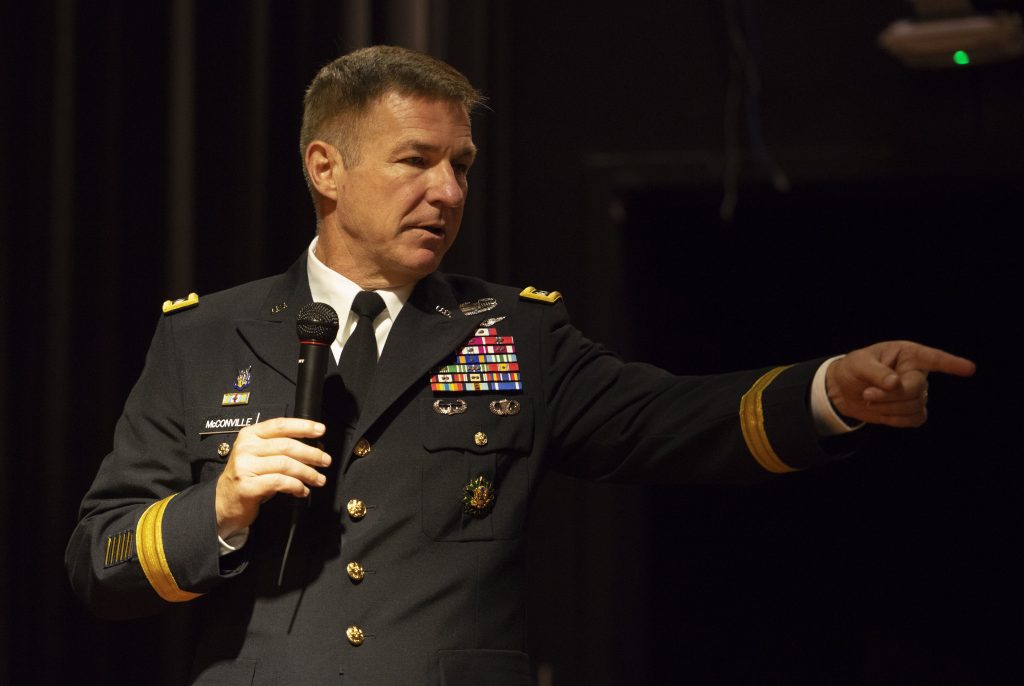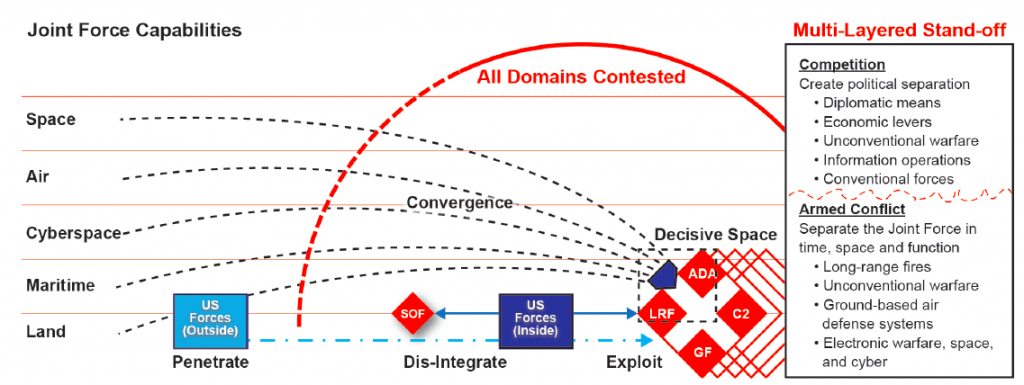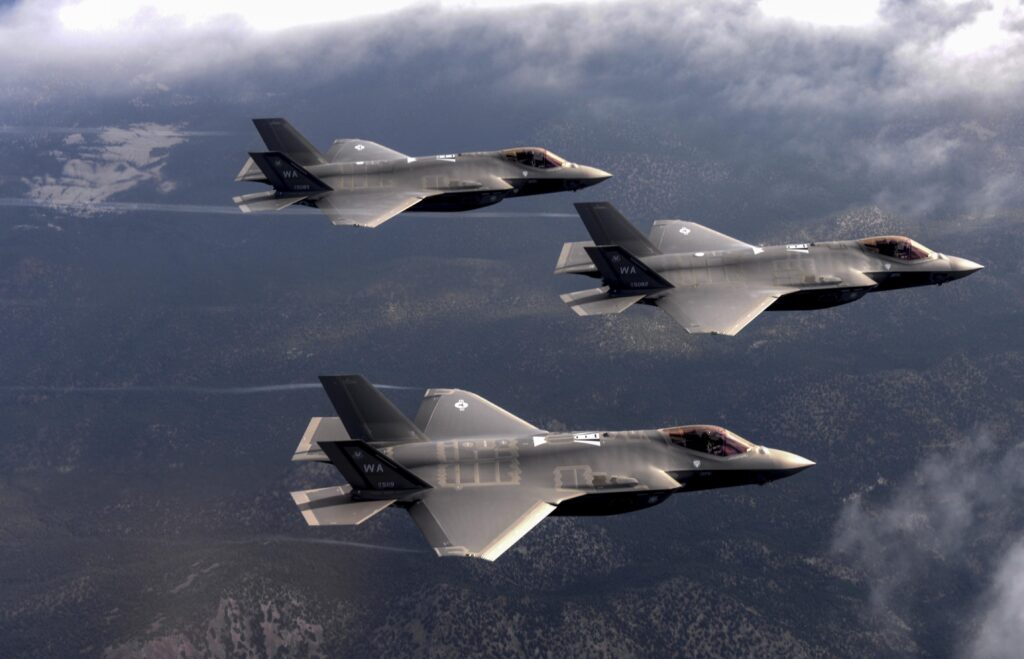
Gen. James McConville
WASHINGTON: The Army and Air Force have started delving deep into the technical nitty-gritty of sharing data and conducting joint experiments in 2021, taking their often-fraught collaboration to new heights after four years of debating broad concepts for future wars.
“We spent a whole day on the Air Force-Army staff talks [last month] coming to an agreement on how we are going to be able to do the machine-to-machine exchange of data,” Gen. James McConville, Army Chief of Staff, said in an exclusive interview with Breaking Defense. Those staff talks led to a new Memorandum Of Understanding (MOU) that McConville signed with his Air Force counterpart, Gen. Charles Brown.
[Click here for more from our exclusive interview with Gen. McConville]

Gen. Charles Brown
Instead of officers manually reentering data from one incompatible system into another, as is often the case today, the two services’ networks must share information directly, automatically and almost instantly, allowing their forces to coordinate quickly and beat high-tech adversaries to the punch.
“You have to do that to get the speed” required to win a high-tech fight, McConville told Sydney. In exercises like last month’s Project Convergence, which linked intelligence satellites and Marine Corps F-35 fighters to Army artillery, “we’ve been able to demonstrate it,” he said.
But getting that connection to work with technology that exists today took a tremendous effort just to link a relative handful of space, air, and ground assets. It took hundreds of engineers, data scientists, coders, and soldiers, and “they were out there for about six weeks working through all the ins and outs,” McConville said.
“We have a lot of hard work to do, a lot more experimentation, a lot more testing, but we’re starting to see the benefits,” he said. “What we’re going to do is align a lot of the experimentation and training that we’re doing,” starting in 2021.

SOURCE: Army Multi-Domain Operations Concept, December 2018.
A Landmark Agreement
The landmark agreement, announced Oct. 2 by the Air Force and Army chiefs, now has their staffs thrashing out exercise schedules and technical protocols for what’s being called CJADC2.
That’s (mercifully) short for Combined Joint All-Domain Command and Control. The clunky jargon is code for a truly ambitious effort: “combined” refers to allies and coalition partners; “joint” to US services; “all-domain” to land, air, sea, space, and cyberspace; “command and control” to coordinating military operations across all those actors and arenas.
“This is a serious commitment between both services to work together,” an Air Force spokesperson told Breaking Defense. “We’re trying to build the interconnected digital infrastructure needed to allow individual services to bring their own capabilities and connect to one another, much like we do in our daily lives at home with personal devices.”
“We’re building the military’s internet of things,” the spokesperson said. “The CJADC2 partnership agreement is meant to solidify our commitment to connecting the Joint Force and build ‘IoT.mil’ together. All-domain superiority doesn’t happen without working together.”
The chiefs’ immediate aim is to connect – but not combine – the two service’s flagship experimentation efforts, the Army’s Project Convergence and the Air Force’s Advanced Battle Management System (ABMS) On-Ramps. Detailed recommendations are due back to McConville and Brown in time for a second summit later this fall.
“Gen. Brown, he and I have both committed to making this happen,” McConville told us. “It starts at the top.”
At the Army-Air Force talks in September, “both chiefs were there, most of our principal staffs were there, some of our acquisition professionals were there,” he said. “But this was just the beginning. We’re going to get back together in about 60 days.”
The director of the new Strategic Operations planning cell (DAMO-SO) created this year on the Army’s Pentagon staff, Brig. Gen. Martin Klein, said the Army and Air Force staffs have set themselves a 45-day deadline to give their chiefs “a plan of action and milestones for ’21, and some suggestions for FY22.”

F-35s over Nellis AFB, Nevada. The services have already experimented with feeding targeting data from F-35 sensors into Army missile defense systems.
There are two separate but mutually reinforcing thrusts, Klein explained: experiments and data.
To find specific venues where the two services can collaborate, Klein said, the staffs are poring over schedules. They’re looking at the Air Force’s thrice-yearly ABMS On-Ramps, the Army’s annual Project Convergence, and a range of other opportunities, from big joint training exercises like Bold Quest to smaller, more technical events, like the Soldier Touchpoints where Army troops give feedback on prototype equipment.
Now, it’s not practical to turn everything on the schedule into a full-fledged Army-Air Force CJADC2 experiment. The goal, Klein said, is to get personnel from both services involved in as many events as possible, not just as passive observers but as active participants sharing expertise and data.
Sharing data, in turn, requires detailed technical exchanges and agreements that the two services’ staffs are now starting to work out, Klein said.
For example, each services’ networks have their own security standards and accreditation processes. Their Authorizing Officers (AO) must approve any new code or connection to their service’s system. A software tool or data feed that has an Army AO’s approval to go onto an Army network doesn’t necessarily meet the standards to go on an Air Force system, and vice versa.
Getting the clearance can take “weeks or months,” Klein said, whereas CJADC2 requires near-real-time flow of data. So the two services are now working out reciprocity agreements with common security standards, whereby each would accept code the other approves without redoing the whole certification process each time.
One thing that makes this collaboration easier, Klein said, is that the two services are taking “surprisingly similar” approaches to cloud computing, albeit with different systems. While the Department of Defense-wide JEDI cloud is still delayed, the new DoD data strategy does prescribe common data standards for all the services.
The ultimate test, Klein said, is to see how data flows – or fails to flow – in a multitude of specific cases: from an F-35 fighter to an M777 howitzer battery, for instance, or from a Reaper drone to a HIMARS missile launcher. The services plan to run detailed engineering analysis of these “mission engineering threads.”
The technical challenges are immense. The Army and the Air Force operate on very different scales. Connecting hundreds aircraft, flying high above obstacles that could block radio transmissions is very different from networking the four-thousand plus ground troops marching through the mud in a single infantry brigade.
“One of the challenges [is] the scale of the Army is huge,” McConville said, “over a million soldiers… compared to a couple of thousand airplanes.”
“So we are very concerned, whatever solution we come up with, it can scale to include the entire Army,” he said.

Army combat doctrine has grown more complex since the 1980s heyday of AirLand Battle.
A Long and Winding Road
It has taken the services four years to get this far. Back in 2016, then-Deputy Secretary of Defense Robert Work challenged the Air Force and Army to come up with a new combat concept he called AirLand Battle 2.0, a 21st century update to the Cold War doctrine of AirLand Battle that guided the services’ devastatingly effective collaboration in the 1991 Gulf War. (The Navy and Air Force were already working on their own version, Air-Sea Battle). But the services decided Air, Land, and Sea were not enough: The new concept needed to address outer space and cyberspace as well.
Four years ago this month, after then-Army Chief of Staff Gen. Mark Milley (now Joint Chiefs chairman) formally rolled out what he called Multi-Domain Battle, his Air Force counterpart, Gen. David Goldfein, made a rare appearance at the Association of the US Army conference to endorse the idea. Within five months, Goldfein offered his own, more technical take on how to coordinate such operations, a proposed all-service network called Multi-Domain Command & Control. That Air Force concept, in turn, led to the Advanced Battle Management System effort.
But many in the Army feared the ABMS network would turn into “one architecture to rule them all” that ignored the land forces’ unique needs, particularly the massive scale of its forces. The biggest contribution of the new agreement may well be that it commits the services to a compromise that both can live with.






















